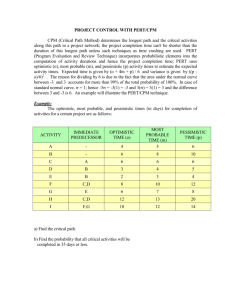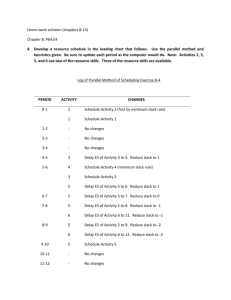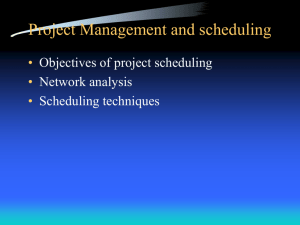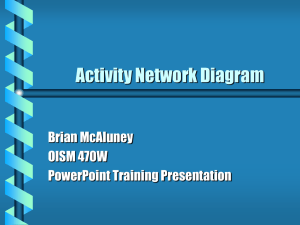Planning
advertisement
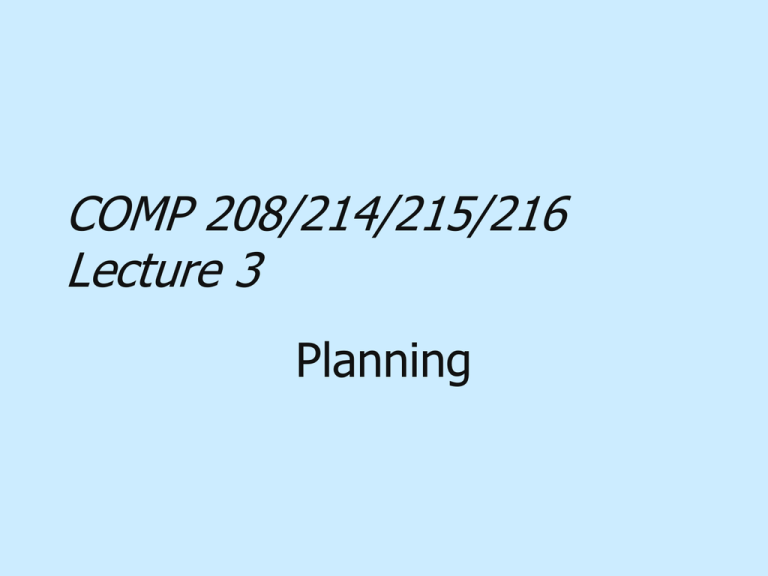
COMP 208/214/215/216 Lecture 3 Planning Planning • Planning is the key to a successful project • It is doubly important when multiple people are involved • Plans are needed to: – Identify what must be done – Allocate work across the team – Co-ordinate the activities of the team. Steps in Planning • • • • • • Work breakdown Time estimates Milestone identification Activity sequencing Scheduling and allocation of people Re-planning Work Breakdown • It is important to think about tasks at the right level of detail • “Do project” is clearly too abstract: – It doesn’t tell you what you need to do – You can’t estimate how long it will take – You can’t tell what progress you have made – It gives no basis for splitting the work. Refine the Tasks Step by Step Group Project Requirements Design Implementation Documentation Refinement of Requirements Requirements Database Planning Mission Statement Mission Objectives System Definition Requirements Collection User Views For each User View Administrator Enquirer Data to be Used How data will be used Sub-tasks taken from Connolly and Begg: “Database Solutions” How far should we refine? • Break the task down until you are sure what the task involves • If the task is likely to take more than a week, probably it should be broken down • If the task is likely to take less than a day, you’ve probably gone too far • Later tasks can be left with less detail until they are reached Too much detail makes re-planning difficult, too little makes planning impossible. Time and Person Estimates • Examine the tasks at the lowest level of detail • For each estimate how long it will take, and how many people are needed and desirable to do it • These estimates are almost always wrong. – Don’t worry about this, but make sure your plan can cope (leave slack in the Plan). Milestone Identification • Milestones are significant events before project completion. – External milestones may have a fixed date • External milestones: – – – – The The The The requirements review design review demonstration final report. • Internal milestones: – e.g. project meetings, Completion of significant tasks (optional). Activity Sequencing • For each task, decide which milestone it must be completed before • For each task, see which tasks must be completed before it can start, and which cannot start until it is completed • Draw a chart showing these relationships. Example Project management and time planning • Pert charts Earliest start Program Evaluation and Review Technique Duration Earliest finish Float Latest finish Task name Latest start slide 14 3SFE519 S Coope 2004 Pert charts • Looking for spare time (float) 0 5 5 Task A 5 5 5 10 1 1 9 10 15 5 20 Task C 10 0 10 Task B 9 slide 15 3SFE519 S Coope 2004 Pert critical path determination 0 5 Task A 5 5 5 10 0 1 Task B 9 9 1 0 20 Task D 0 0 20 5 10 Task C 10 5 15 20 20 30 50 0 50 Task E 20 10 20 slide 16 3SFE519 S Coope 2004 At This Point: • We can identify: – What must be done in parallel – When tasks must start, and which have flexibility – Potential problems: latest start date is before earliest start date • In the last case re-planning is needed: – – – – Split the task Change the time estimate Reconsider dependencies Reduce the task. Scheduling • We now decide which task will start when • Gantt Charts are commonly used • They show explicitly how long tasks will take, what must be done in parallel, and what slack there is in the plan – The more slack you have the better. Gantt Chart for example • Horizontal axis shows time steps/Vertical axis shows tasks • Black shows no float • Shaded shows float • White shows earliest possible scheduling • Milestones shown as diamonds at end of last task. Allocation of People - I • What is desirable? • Some tasks naturally require different numbers of people; – The whole group (e.g. deciding on the application area): • Everyone needs to agree and be involved – Pairs (e.g. requirements collection for a use case) • 2 heads are better than 1: It helps to talk – Individuals - (e.g. drawing a diagram, implementing a piece of code) - but someone else reviewing the work may be helpful. • It is easier for a fresh eye to spot any problems. People allocation and risk • Try and have 2 people on each task (main and backup) • Skills and risk issue • Make sure main person keeps backup person informed • Project leader should – Make sure each task has appropriate backups – Talk to backup people in the contingency of main developer not available Allocation of People -II • What is possible? • If tasks need to be done in parallel, it may be essential to split your resources across them • Different people may have different skills and interests. Allocation of People - III • Better if everyone has something to do all the time – There are on-going background tasks, such as data acquisition which can be done at “any” time • Try to avoid too much waiting for other people to finish • Spread the work evenly over people and time • Try to keep slack in your plan. Re-planning • Plans are never perfect: things will go wrong or well. – Modify the plan - don’t throw it away • A task finishes late and there was no slack: other tasks must be completed more quickly – Use more people; reduce the task; • Tasks are finished early – Move an activity forward; always try to create slack • New tasks are identified in the course of the project – Add them to the plan • Tasks are no longer needed – Remove them from the plan. If You Have A Good Plan • Everyone knows what to do, when they need to do it, and why they are doing it • Potential difficulties will be anticipated • Things will be completed on time • Work will be divided fairly • Everyone will be happy.





